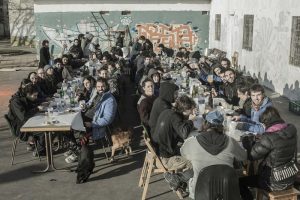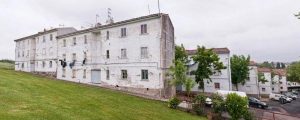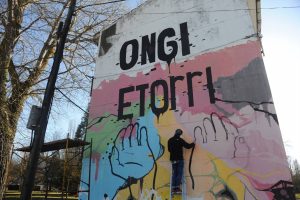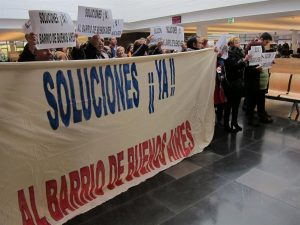 15M changed the face of Spain. Below the new electoral parties that changed parliamentary, regional, and autonomic power relations, the changes that grassroots movements are making are as powerful as those of Podemos, but much less visible.
15M changed the face of Spain. Below the new electoral parties that changed parliamentary, regional, and autonomic power relations, the changes that grassroots movements are making are as powerful as those of Podemos, but much less visible.
“This reminds me of what we experienced over there,” says Fabricio, an Argentine who was part of the piquetero Darío Santillán Popular Front and now lives with his partner and son in Errekaleor, in the Gasteiz/Vitoria outskirts. Crises seem to awaken the creativity of human beings, based on recuperating the traditions that still lurk in the communal memory of the species.
What excites Fabricio is the ability to recreate life in the margins with housing, cultural, and productive projects similar to those he knew in his youth in the Buenos Aires metropolitan area. In Spain these kinds of enterprises abound, born of social movements as a response to unemployment and job insecurity. They proliferate mostly on the outskirts of cities, from the gardening communities surrounding Valencia to the Basque, Galician, and Asturian cities, passing through Madrid and the Castilian steppe.
The projects of the Spanish movements have some characteristics in common with those the piqueteros employed and with the projects that landless and indigenous peoples still have. The most important similarity is the territorial base of resistance, which allows groups to create alternative lifestyles in their own spaces, develop cultures different from the hegemonic, and build self-controlled educational spaces.
None of this would have been possible without the crisis. But the big challenge, as everywhere, is whether they will continue to resist when things improve, although so far nothing indicates that will happen.
The three grassroots experiences described below are the daughters of 15M, though some were born long before that date. The massive encampments in plazas after the people’s occupation of Puerta del Sol in March 2011 gave the social movements the momentum and the vision to come out from the margins. They became vibrant and dignified alternatives for hundreds of thousands of Spanish people. The massive occupation of Sol, to name just the first case, set the starting signal. Then, above all, the demonstration of “Yes, we can!” served to flesh out the growing movements.
These events marked the passage from impotence to action, from the character of spectators to protagonists. It was, in short, the beginning of a shift in the political culture that had been established during the transition following the death of Franco in 1975.
A barrio priest
His name is Emiliano Tapia, and he came to the Santa Maria Nazareth parish on a May 1st, 22 years ago. He chose the most marginalized neighborhood of the tourist city of Salamanca to realize his Christian dream of working with the poorest, not out of charity but to learn together with them. The Buenos Aires barrio houses 350 family dwellings in four-story buildings–1,500 people living four kilometers from the city center. The neighborhood was born in 1983 to receive impoverished families.
More than two decades later, things got worse. Urban isolation, unemployment and job insecurity, deterioration of infrastructure, drug dealing, and internal conflicts plague the neighborhood, where two-thirds are Roma. In short, a ‘ghetto.’
“Barrios with no return,” Father Emiliano labels them. He insists on “accompaniment in the process of dignifying life.” Among all the problems, he highlights massive school absenteeism, perhaps because he insists on looking forward. “From the age of twelve on, breakdown and absenteeism is almost total in children of families, related to drug trafficking,” says Father Emiliano.
“Those in power, talk about the problems but don’t solve them,” says the “red” priest, as he’s known elsewhere on the peninsula. To address past problems, he spearheaded the creation of the Community Development Association of Buenos Aires (Asdecoba) in the 1990s. The Association complements the work of the neighborhood association and the women’s association. They use games to do street education for children, but recognize that ties with the Roma community are very weak. One of the women working in the parish shows the priest’s car with long scratches in the paint, an example of the response of drug dealers to a priest who questions them. They have threatened him on several occasions, but have not resorted to direct attacks, at least for now.
 The father is not a man of complaint, but of action. He gets in the car and offers to show us what they do in Asdecoba to solve everyday problems. The first stop is in the barrio itself, where a catering service run by 20 people–poor, ex-prisoners, and immigrants–distributes 300 meals to elderly people living alone who cannot cook for themselves every day, as part of an agreement with the municipality. The workers manage the Algo Nuevo catering enterprise themselves. They receive the same income and proudly display an industrial kitchen with modern equipment they bought with their earnings.
The father is not a man of complaint, but of action. He gets in the car and offers to show us what they do in Asdecoba to solve everyday problems. The first stop is in the barrio itself, where a catering service run by 20 people–poor, ex-prisoners, and immigrants–distributes 300 meals to elderly people living alone who cannot cook for themselves every day, as part of an agreement with the municipality. The workers manage the Algo Nuevo catering enterprise themselves. They receive the same income and proudly display an industrial kitchen with modern equipment they bought with their earnings.
The second stop is the plots provided by neighbors who no longer cultivate the land, located several kilometers from the barrio. It is about three hectares in total where community members grow vegetables, and run a large greenhouse with seedlings and winter crops. Last year they harvested 24 tons of potatoes and this year they opened a small food processor where four people work. A former nun waters newly transplanted lettuce with a watering can and incredible tenacity.
Further along, are rows of cabbage, beans, onions, beets, and garlic, where several people work away. “We grow without chemicals, but I refuse to label them ‘organic products’ because those are for rich people. Those who use chemicals should be the ones to put on labels,” says Emiliano in an energetic and serene tone.
Among all of these enterprises, we count almost a hundred people who escaped from the clutches of the drug traffickers, prisons, and abject poverty. At one point, they blocked the highway denouncing solutions that fail to arrive, which shows that they are devout believers but do not trust that God will solve earthly problems. They belong to a state collective by the name of Baladre, which defines itself as the “coordination of struggle against unemployment, impoverishment, and social exclusion.”
A self-managed barrio
The young people occupying Errekaleor know it is the largest self-managed barrio in Spain. Errekaleor Bizirik, Errekaleor Vivo is the slogan that drove them to recover the large area three years ago, an area founded in the 1950s to accommodate farmers who came to work in the burgeoning industry of Álaves.
There are 192 dwellings in blocks that housed, in moments of splendor, 1,200 people, “on the periphery of the periphery of the city,” as one of the neighborhood texts states. It is surrounded by fields and a large urban development project that emptied out when the housing bubble burst. The Vitoria municipality began to relocate elderly residents to other barrios to knock down all the blocks, because Errekaleor is located on the fringe of expansion for large property developers.
The barrio was semi-abandoned when a group of students took the initiative to begin to repopulate it in September 2013. They agreed with the few community members who remained to occupy some blocks, and immediately reopened the movie theater and the sport court, renovated houses, and planted a vegetable garden. They also carried out an extensive cultural program, using the church as a youth center for concerts, which is one of the ways they finance the project.
Three years later, there are already 120 people in the barrio. They opened a bakery and a chicken coop as part of their work toward food sovereignty and installed solar panels to achieve energy sovereignty. These are utopias, able to inspire people from Vitoria who visit the self-managed neighborhood by the dozens. It was also is a way to dissuade the municipality from trying to forcibly evict barrio residents when the project was growing and gaining supporters in the city.
Awhile back, the authorities cut off their electricity with the excuse that the dilapidated facilities could lead to accidents. Residents decided to make meals in the common areas that have electricity and take advantage of them to plan Sunday assemblies. In the municipality, they count on the complicity of the independence party Bildu. In early May they opened the barrio to the city, set up a popular market where they teach small-scale fruit and vegetable production and workshops, serve meals, put together dances and children’s play areas, and show documentaries.

Explaining to those who are not militants that this is a comprehensive project–not just housing–has not been simple. A couple of violent community members were expelled from the barrio when their partners accepted the proposal of young women to combat gender violence. Feminist occupants set up a support group for battered women. Every now and again they carry out an auzolan (“collective work” in Basque), attended by people from all parts of Basque Country. They collaborate in painting murals, the expansion of the garden, alternative education, or simply cleaning the barrio. Social movements are turning to self-management and seem alert to a possible eviction.
Jonbe Agirre, one of the students involved from the beginning, says, “at first it was a project closely linked to young people, but we eventually saw that people of the most varied profiles can live here if they share the project’s foundations.” So far, the most energy is dedicated to rehabilitate housing which, with little variation, has suffered a long process of deterioration by abandonment and humidity.
Similar experiences are evident in other places in Spain. The CGT Valencia Assembly of the Unemployed and Precarious has an office to advise the unemployed on their rights, and solidarity and support in food they baptized CAOS (Self-Help Solidarity Worker Food Basket), which distributes foods donated by members with permanent employment as a way of forging links between the two sectors. Ropero Solidario delivers clothing to those in need and a textile workshop employs three people from the assembly to work with an industrial machine. They don’t receive a single euro from the government, and display the slogan “Against state dependence: grassroots autonomy.”
Movement school
Self-education is no longer the exclusive preserve of Latin American social movements, if it ever was. The last weekend in April almost a hundred activists from groups throughout the Spanish state participated in three days of discussion on the outskirts of Madrid. For the second year, the Ramón Fernandez Duran Social School ran in homage to one of the most charismatic environmentalist and anti-capitalist militants.
The libertarian union General Labor Confederation (CGT), Ecologists in Action, and Baladre, convened the school. The three collectives have been working together for a few years. They decided to devote the two main sessions to reflect on strategies based on two triggers: the analysis of the current situation and possible scenarios in 10-20 years; and how to relate institutional strategies, social movement strategies, and building alternatives. Specialists from the movements had just fifteen minutes to synthesize their ideas, thus avoiding long digressions. Then they worked in groups with their own popular education dynamics–work methods almost identical to those Latin American movements use. One of the recurrent discussions was how to combine work in institutions with strengthening street activity, also a major issue in Latin America.
Toni Valero from Koordinadora of Kolectivos in Alcosa Park, a suburban dormitory eight kilometers from the city of Valencia, participated in the discussions. As with Errekaleor, Alcosa was born in the 1960s in the heat of Franquista developmentalism to house waves of migrants from rural Andalusia and Extremadura. Today about 10,000 people live there, including new Latino and Maghreb immigrants. The Park’s unemployment rates oscillate around 40%, 70% of the population lives below the poverty line, and there are high rates of substance abuse and mental health problems, and school absenteeism and functional illiteracy.
The Koordinadora brings together associations working in social and cultural projects. There are 14 people’s employment initiatives that have created more than 140 jobs and served more than 500 people. Toni highlights their street-cleaning cooperative that recently won a municipal bid against private companies.
Everything has been achieved with bold action, occupations, encampments, and hunger strikes. In 2013 they spent more than a month in the Infinite Patience encampment, a name that satirizes the attitude of the authorities.
Toni teaches the harsh reality of their working culture, which leads him to say that the crisis is a story: “To continue accumulating, they have to stop growing and suck on others in a process of concentration that never ends. So we can’t say that capitalism is in crisis; capitalism is like that, at times it expands and at others it contracts, but in both cases, it continues to accumulate.”
For residents of Alcosa Park, however, the ongoing crisis worsened the conditions of marginalization they’ve always experienced. The barrio coordinator has been with people in crisis due to unemployment for 30 years, situations now aggravated by job insecurity, short-term contracts, and miserable wages. Workers who can’t organize in their workplace choose to do so in their territories where they feel, despite the police presence, safer and protected by others suffering the same situation.
 At some point there will be time to reflect on the relationship between so-called micro or local experiences and changes at the macro level that pass through parties of a new type (such as Podemos and the municipal candidatures Ahora Madrid, Barcelona en Comú, and many others) and large demonstrations called mareas (tides). The conviction growing amongst the activists is that it is not one or the other, but some form of feedback between the two modes that allows, in turn, the fortification of the micro and the macro. Nobody has the formula, but the desire to change is bubbling up all over.
At some point there will be time to reflect on the relationship between so-called micro or local experiences and changes at the macro level that pass through parties of a new type (such as Podemos and the municipal candidatures Ahora Madrid, Barcelona en Comú, and many others) and large demonstrations called mareas (tides). The conviction growing amongst the activists is that it is not one or the other, but some form of feedback between the two modes that allows, in turn, the fortification of the micro and the macro. Nobody has the formula, but the desire to change is bubbling up all over.



